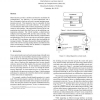Free Online Productivity Tools
i2Speak
i2Symbol
i2OCR
iTex2Img
iWeb2Print
iWeb2Shot
i2Type
iPdf2Split
iPdf2Merge
i2Bopomofo
i2Arabic
i2Style
i2Image
i2PDF
iLatex2Rtf
Sci2ools
ICS
1993
Tsinghua U.
1993
Tsinghua U.
Anatomy of a Message in the Alewife Multiprocessor
Shared-memory provides a uniform and attractive mechanism for communication. For efficiency, it is often implemented with a layer of interpretive hardware on top of a message-passingcommunications network. This interpretive layer is responsible for data location, data movement, and cache coherence. It uses patterns of communication that benefit common programming styles, but which are only heuristics. This suggests that certain styles of communication may benefit from direct access to the underlying communications substrate. The Alewife machine, a shared-memory multiprocessor being built at MIT, provides such an interface. The interface is an integral part of the shared memory implementation and affords direct, user-level accessto the network queues, supports an efficient DMA mechanism, and includes fast trap handling for message reception. This paper discussesthe design and implementation of the Alewife message-passing interface and addresses the issues and advantages of using su...
Alewife Message-passing Interface | Attractive Mechanism | Distributed And Parallel Computing | ICS 1993 | Shared Memory |
Related Content
| Added | 09 Aug 2010 |
| Updated | 09 Aug 2010 |
| Type | Conference |
| Year | 1993 |
| Where | ICS |
| Authors | John Kubiatowicz, Anant Agarwal |
Comments (0)

